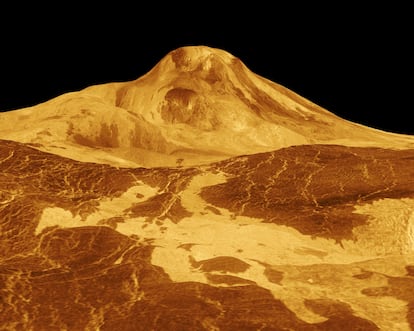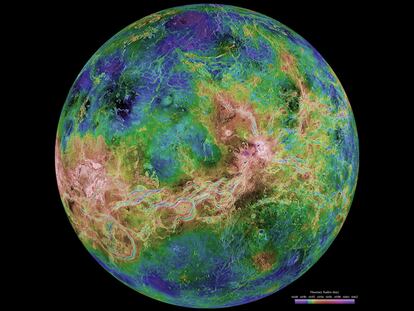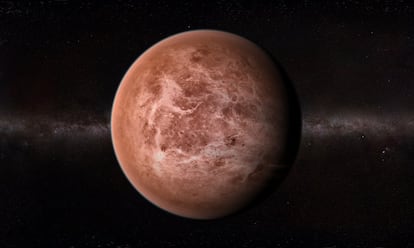Scientists discover active volcano on Venus
Radar images taken by a probe in 1991 suggest there was an eruption on the planet that was double that of Hawaii’s Kilauea volcano

Radar images taken more than 30 years ago have provided the most conclusive evidence of an erupting volcano on Venus, Earth’s twin planet that, for unknown reasons, became a hellish world with a surface temperature of 500º C (924º F) – hot enough to melt lead.
In 1991, NASA’s Magellan probe – named after the Portuguese explorer who led the 1519 expedition that circumnavigated the world – mapped the surface of Venus using radar. Radio signals pierced the thick clouds and revealed the orography of the planet in three dimensions. Mankind gazed upon a planet riddled with volcanoes, though it was impossible to tell whether they were active or geological relics from the remote past.
Magellan easily broke the record for the amount of information sent to Earth from another planet: 1,200 gigabytes, more than all previous missions combined. Today, it’s a laughable figure. But some of the radar images were so large that, for a long time, it was not possible to analyze them in detail with conventional computers, explains Scott Hensley, a researcher at NASA’s Jet Propulsion Laboratory. A few years ago, this physicist began to compare images of an area taken by the Magellan in two separate trips in February and October 1991. The results, published in the prestigious journal Science, provide the strongest proof to date that Earth is not the only planet in the Solar System with active volcanoes.

The images of the first crossing showed a volcanic fissure of about two square kilometers (0.7 square miles), with a depth of 175 meters – a size equivalent to a 58-story skyscraper. When the probe passed over the same point again eight months later, the crack had doubled in size and appeared to have filled up with a material that scientists think can only be lava. According to the study, the molten rock would have covered an area of almost 70 square meters, more or less double that caused by the 2018 eruption of the Kilauea volcano, in Hawaii.
Although it is not “100% certain” that it is the sign of a volcanic eruption, since the observations are almost at the limit of the image resolution of the radar, it is “the most plausible explanation,” says Hensley. The new eruption is on the slopes of Maat Mons, the highest volcano on Venus, which was thought to be extinct.
Robert Herrick is a geophysicist at the University of Alaska at Fairbanks and a co-author of the study. “Until now there was indirect evidence of volcanism on Venus,” he explains. “There are indications of chemical reactions that point to eruptions and other geological activity data, but it could not be determined whether they happened thousands of years ago or were happening right now. Our work shows a new volcanic structure that formed in eight months in 1991 and is the most conclusive proof of an eruption on the planet,” he says.
Based on this study, Venus would be the second planet in the Solar System with active volcanoes after Earth. In addition to these two planets, active volcanoes can also be found on Io, Jupiter’s moon, undoubtedly the most active body in the entire Solar System, where hundreds of volcanoes spew lava fountains several miles high.
In December, researchers discovered on Mars an active volcanic area as large as all of Europe, which could erupt at any time. Finding volcanoes is always significant as, at least on Earth, they can create habitable environments for living creatures.

The possibility of life on Venus is remote, but not impossible. In September 2020, scientists from Europe and the US announced they had discovered phosphine, a chemical compound in the atmosphere, which could be the first evidence of life on Venus. Since then, various teams have tried unsuccessfully to replicate that discovery, and the possibility of the planet being habitable has dwindled.
Iván López, a planetary geologist from Rey Juan Carlos University in Madrid, is an expert in Venusian geology and is involved in the European Space Agency’s ExoMars mission. “Venus and Earth were born as twins,” he explains. “They have practically the same size and the same composition. Venus may even have water. But something happened that triggered a runaway greenhouse effect. All experts on Venus think that there are active volcanoes, but the truth is that there has been no conclusive evidence so far. We do know that this planet does not have tectonic plates like Earth. So understanding how it is possible for volcanoes to occur without plates can help us better understand an alternative mechanism of volcanism and even explain how tectonics originated on Earth, which is essential for the planet to be habitable,” he explains.
In 2031, the United States and Europe will launch two new missions to Venus to study the thick atmosphere for life and its scorching, orange surface. Hensley and Herrick are working with both missions, Veritas and EnVision, respectively, developing the new radars that will re-map the planet for volcanic activity.
On April 27, 1521, explorer Ferdinand Magellan was killed by the natives of the island of Mactan (Philippines). The Basque explorer Juan Sebastián Elcano took command of the expedition, completing the first circumnavigation of the Earth before returning to Spain. The Magellan space probe can also be thought to have died in combat. In October 1994, NASA engineers sent the spacecraft plunging into the clouds of Venus until it disintegrated. However, the data from the probe may offer many more surprises, says Herrick: “The probe covered at least twice up to 40% of the surface of Venus, and so far we have only analyzed 1.5% in detail.”
Sign up for our weekly newsletter to get more English-language news coverage from EL PAÍS USA Edition
Tu suscripción se está usando en otro dispositivo
¿Quieres añadir otro usuario a tu suscripción?
Si continúas leyendo en este dispositivo, no se podrá leer en el otro.
FlechaTu suscripción se está usando en otro dispositivo y solo puedes acceder a EL PAÍS desde un dispositivo a la vez.
Si quieres compartir tu cuenta, cambia tu suscripción a la modalidad Premium, así podrás añadir otro usuario. Cada uno accederá con su propia cuenta de email, lo que os permitirá personalizar vuestra experiencia en EL PAÍS.
¿Tienes una suscripción de empresa? Accede aquí para contratar más cuentas.
En el caso de no saber quién está usando tu cuenta, te recomendamos cambiar tu contraseña aquí.
Si decides continuar compartiendo tu cuenta, este mensaje se mostrará en tu dispositivo y en el de la otra persona que está usando tu cuenta de forma indefinida, afectando a tu experiencia de lectura. Puedes consultar aquí los términos y condiciones de la suscripción digital.









































